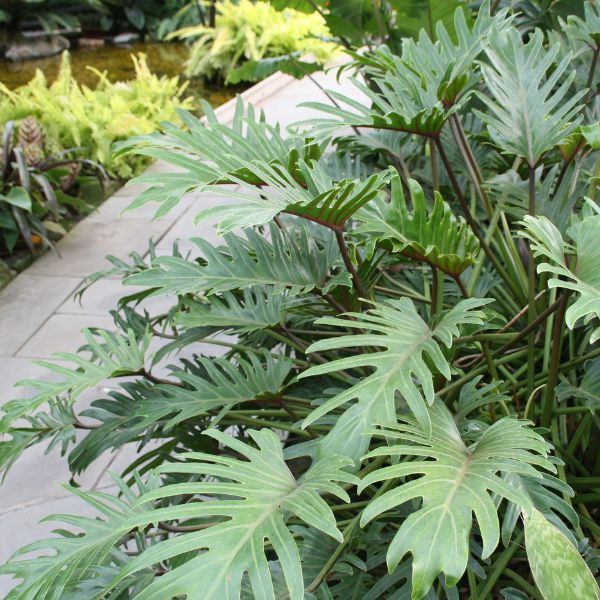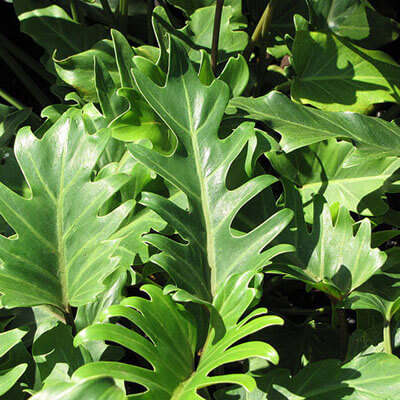


Philodendron Xanadu
Philodendron bipinnatifidum 'Xanadu'
91 reviews
Philodendron Xanadu
Philodendron bipinnatifidum 'Xanadu'
91 reviews
- 1 Gallon
- Quart Container
We are sorry, product is currently out of stock due to seasonal availability. Please check the "Related plants available in your area" section below
Not just beautiful - intentionally selected by ShrubHub's 3D landscape design team to fit real-world spaces and maximize yard potential.
Why Philodendron Xanadu?
Philodendron Xanadu, also known as Philodendron bipinnatifidum ‘Xanadu’, is a popular ornamental plant. It features attractive, large, deeply-lobed leaves with a glossy texture and a dense growth habit. This plant is known for its ability to tolerate a range of light conditions, making it suitable for both indoor and outdoor cultivation. Its compact size and low-maintenance nature make it a favorite among plant enthusiasts and gardeners alike.
Sunlight
Philodendron Xanadu thrives in bright, indirect sunlight. It can tolerate some shade, but direct sunlight should be avoided as it can scorch its foliage. Place it near a window with filtered light or in a partially shaded area.
Watering
Philodendron Xanadu requires regular watering, with the soil kept evenly moist but not waterlogged. It is essential to let the top layer of soil dry out between watering to prevent overwatering and root rot.
Fertilizing
Philodendron Xanadu prefers a well-balanced, slow-release fertilizer that is high in nitrogen. It is recommended to fertilize this plant every 2-3 months during the growing season, following the instructions provided on the fertilizer packaging.
Philodendron Xanadu (Philodendron bipinnatifidum 'Xanadu')
The Philodendron Xanadu, scientifically known as Philodendron bipinnatifidum 'Xanadu', is a popular tropical plant that belongs to the Araceae family. With its attractive foliage and ease of care, it has become a favorite among plant enthusiasts.
Description
The Philodendron Xanadu is a compact and clumping evergreen perennial, characterized by its dense and glossy green foliage. The leaves are deeply divided and have an attractive lobed shape, giving them a unique decorative appeal. The plant typically grows to a height of 2 to 4 feet and has a spread of around 3 to 6 feet, making it an excellent choice for both indoor and outdoor landscaping.
Care Requirements
The Philodendron Xanadu is relatively easy to care for, making it suitable for beginners and experienced plant owners alike. However, it thrives best in bright, indirect light and prefers temperatures between 65°F and 75°F. It can tolerate some direct sunlight, but excessive exposure may lead to leaf burn. It is important to ensure well-draining soil and avoid overwatering, as this plant is susceptible to root rot. Watering should be done when the top inch of soil feels dry. Regular misting can also help increase humidity levels, preventing the leaves from drying out.
Fertilizing the Philodendron Xanadu is essential to promote healthy growth. A balanced liquid fertilizer can be applied once every month during the growing season (spring and summer). Pruning can be done to maintain its shape and remove any dead or yellowing leaves.
Design Uses
The Philodendron Xanadu is highly valued for its ornate appearance, making it an ideal choice for both indoor and outdoor use. It is commonly utilized in landscapes, gardens, and as a houseplant due to its ability to purify the air and add a touch of natural beauty to any space. It can be used as a focal point in a pot or container, as well as in mixed plantings for a lush tropical look.
It is important to note that while the Philodendron Xanadu is generally considered safe, it can be mildly toxic if ingested. Therefore, it is advisable to keep it away from curious pets and small children.
Plant Information:
| Botanical Name: | Philodendron bipinnatifidum 'Xanadu' |
| USDA Zones: | 10 - 11 |
| Water: | Medium |
| Soil Needs: | Well Drained Soil |
| Mature Height: | 2 - 3 feet |
| Mature Spread: | 3 - 4 feet |


Pollination Info
Pollination Information for Philodendron Xanadu (Philodendron bipinnatifidum 'Xanadu')
Philodendron Xanadu, a cultivar of Philodendron bipinnatifidum, is a popular ornamental plant known for its attractive foliage. While it is primarily propagated through vegetative means such as division and cuttings, pollination plays a crucial role in the production of seeds for propagation.
Pollination Process
Philodendron Xanadu belongs to the Araceae family, which are commonly pollinated by insects attracted to their flowers. The pollination process involves several steps:
- Flowering: Philodendron Xanadu produces small, inconspicuous flowers that are often surrounded by a modified leaf called a spathe. These flowers are usually arranged on a spadix, which is a central spike-like structure.
- Attracting Pollinators: The flowers emit a subtle fragrance and produce nectar to attract pollinators such as bees, flies, and beetles. These insects are enticed by the scent and nectar and are important in the transfer of pollen.
- Pollen Transfer: As the insects land on the spathe, they come into contact with the male flowers' pollen, which is present on the spadix. Some of this pollen gets attached to the insect's body.
- Visiting Female Flowers: The insects, now carrying the pollen, move to other female flowers either on the same plant or on different plants. During this process, some of the pollen grains will adhere to the receptive structures of the female flowers known as the stigma.
- Fertilization and Seed Production: If successful, the pollinated flowers undergo fertilization, leading to the production of seeds. It is important to note that Philodendron Xanadu is more commonly propagated through asexual means due to the ease and reliability of vegetative reproduction.
Importance of Pollination
Pollination is essential for maintaining genetic diversity within a plant species. It allows for the exchange and recombination of genetic material, leading to improved vigor and adaptation to changing environmental conditions. Additionally, the production of seeds through pollination serves as a means of reproduction and dispersal.
Pollination Challenges and Considerations
While Philodendron Xanadu is capable of producing flowers and setting seeds, it may not be as common as other species within the same family. This could be due to the plant's adaptation to vegetative reproduction or the reliance on specific pollinators that may not frequently visit urban environments where these plants are commonly grown as houseplants.
It is important to provide a suitable environment for attracting pollinators when attempting to promote pollination in Philodendron Xanadu. This includes providing flowering plants in proximity to attract beneficial insects and ensuring a healthy ecosystem for the plants to thrive.
FAQ
Frequently Asked Questions - Philodendron Xanadu (Philodendron bipinnatifidum 'Xanadu')
Q: What is the botanical name of Philodendron Xanadu?
A: The botanical name for Philodendron Xanadu is Philodendron bipinnatifidum 'Xanadu'.
Q: What are the key characteristics of Philodendron Xanadu?
A: Philodendron Xanadu is a compact, clumping plant with lush green, deeply lobed leaves. It features a bushy appearance and can grow up to 3 feet in height and width.
Q: What are the ideal growing conditions for Philodendron Xanadu?
A: Philodendron Xanadu thrives in bright, indirect light. It prefers well-draining soil and moderate humidity. The ideal temperature for this plant is between 60°F and 75°F (15°C - 24°C).
Q: How often should I water my Philodendron Xanadu?
A: Water your Philodendron Xanadu when the top inch of soil feels dry. It is important to avoid overwatering, as it can lead to root rot. The frequency of watering may vary depending on the climate and the amount of light the plant receives.
Q: Should I fertilize my Philodendron Xanadu?
A: Yes, you should fertilize your Philodendron Xanadu every 2-4 weeks during the growing season (spring and summer). Use a balanced houseplant fertilizer or a slow-release granular fertilizer according to the package instructions.
Q: How often should I repot my Philodendron Xanadu?
A: Repotting is usually required every 2-3 years or when the plant becomes root-bound. Choose a pot that is slightly larger than the current one, use well-draining potting mix, and ensure proper drainage.
Q: Can I propagate Philodendron Xanadu?
A: Yes, Philodendron Xanadu can be propagated through stem cuttings. Choose a healthy stem with several leaves, make a clean cut just below a node, and place the cutting in water or a well-draining potting mix. Keep it in a warm and humid environment until roots develop.
Q: Is Philodendron Xanadu toxic to pets?
A: Yes, Philodendron Xanadu is toxic to both cats and dogs. It contains calcium oxalate crystals, which can cause oral irritation, drooling, and difficulty swallowing if ingested. Keep it out of reach of pets and children.
Q: How can I maintain the compact shape of my Philodendron Xanadu?
A: Regular pruning is essential to maintain the bushy and compact form of Philodendron Xanadu. Remove any yellow or damaged leaves and trim back excessive growth to encourage branching. Pinching back the stems can also help promote compactness.
Planting & Care
Planting & Care for Philodendron Xanadu (Philodendron bipinnatifidum 'Xanadu')
Planting:
- Choose a location with bright, indirect sunlight for your Philodendron Xanadu.
- Ensure the soil is well-draining and rich in organic content.
- Dig a hole that is slightly larger than the root ball of the plant.
- Gently remove the plant from its container and loosen the roots slightly.
- Place the root ball in the hole and backfill with soil, firming it gently around the base.
- Water the plant thoroughly after planting.
Care:
- Watering: Keep the soil evenly moist but avoid overwatering as it can lead to root rot. Allow the top inch of soil to dry between waterings.
- Light: Philodendron Xanadu prefers bright, indirect light. Avoid direct sunlight as it can scorch the leaves.
- Temperature: This plant thrives in average room temperatures between 65-85°F (18-29°C). Avoid placing it in cold drafts or excessively hot areas.
- Humidity: Philodendron Xanadu loves high humidity. Mist the leaves regularly or place a humidity tray nearby to increase humidity levels.
- Fertilization: Feed the plant with a balanced, water-soluble fertilizer once a month during the growing season (spring and summer). Dilute the fertilizer to half strength to avoid over-fertilization.
- Pruning: Trim any yellow or dead leaves to promote healthier growth. You can also prune the plant to maintain its desired shape and size.
- Propagation: Philodendron Xanadu can be propagated through stem cuttings. Take a 4-6 inch cutting with a few leaves and place it in a jar of water or a well-draining potting mix until roots develop.
- Pests: Watch out for common houseplant pests such as aphids, mealybugs, and spider mites. If infested, treat the plant with an appropriate insecticide or use natural remedies like neem oil or insecticidal soap.
Check Out These Verified Customer Reviews:
Customer Reviews
4.7 out of 5 based on 91 reviews
Thank you! Your review has been submitted.
Easy ordering process and fast shipping
Absolutely stunning plant! It arrived in perfect condition and looks even better than the pictures.
Impressed with overall experience
Item has been added to your cart.


